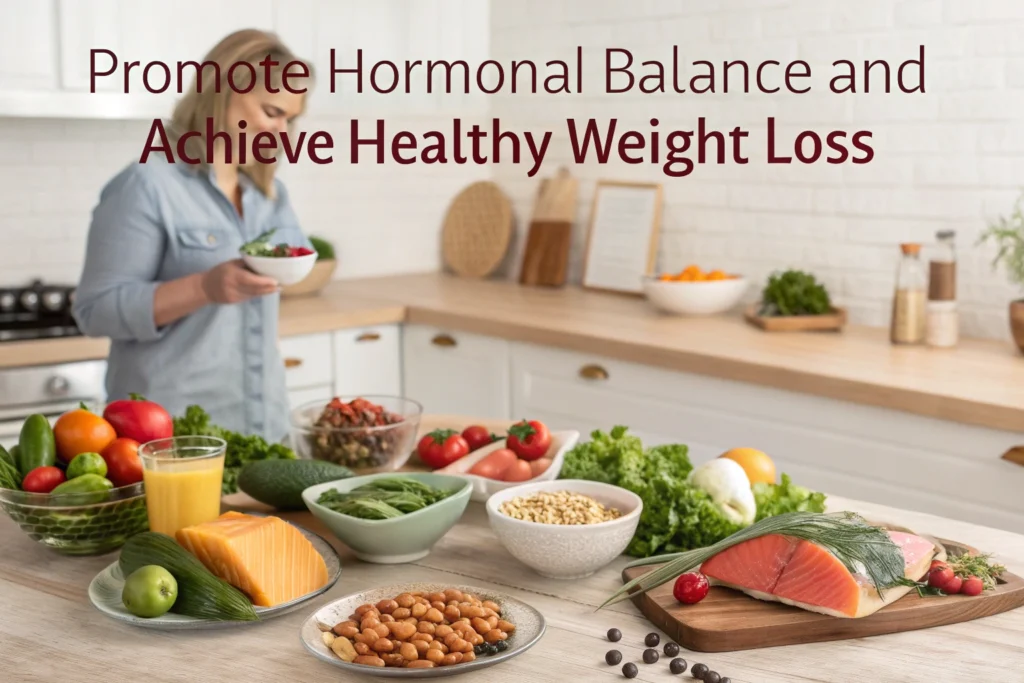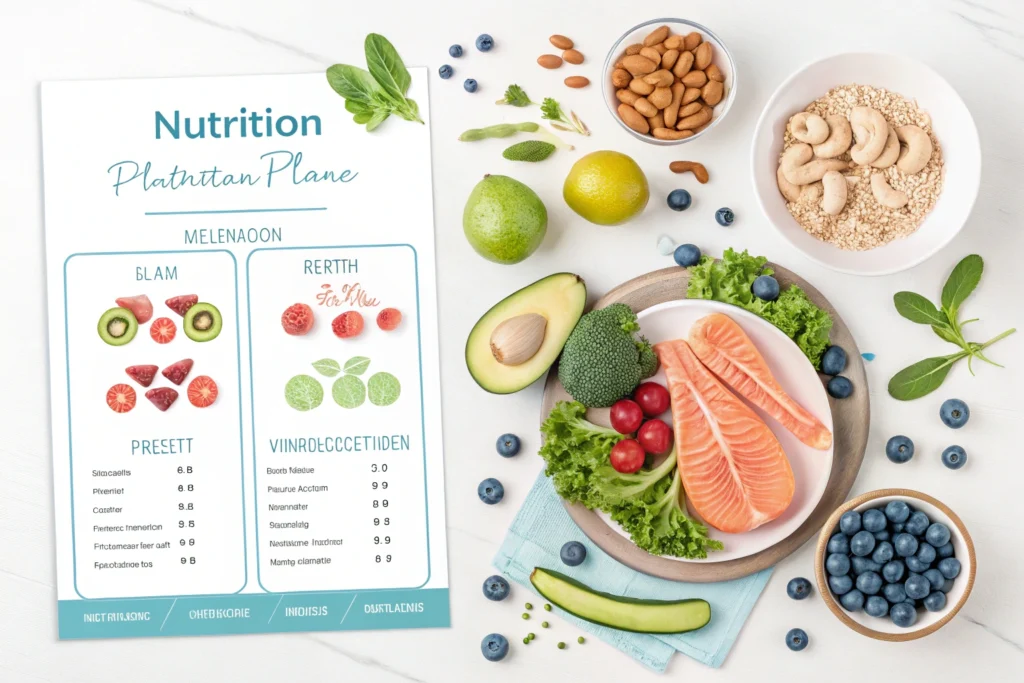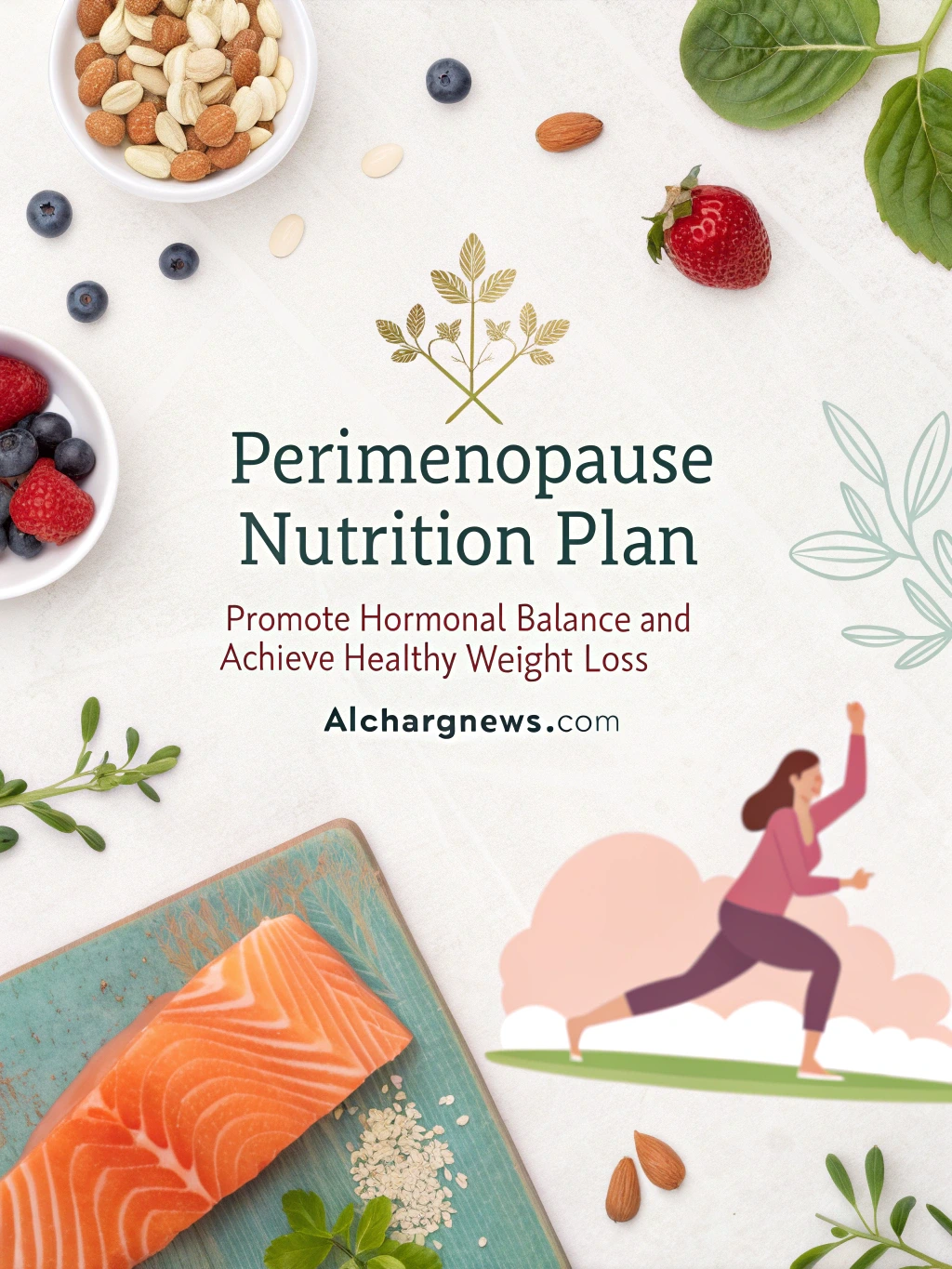Introduction: Navigating the Midlife Nutritional Maze
Standing in my kitchen at 46, I stared at my reflection in the microwave door. Despite my consistent exercise routine and supposedly “healthy” diet, the extra pounds around my midsection refused to budge. Sound familiar? For millions of women entering perimenopause, this frustrating scenario plays out daily. The rules of nutrition that worked for decades suddenly seem to betray us as hormonal shifts rewrite our body’s instruction manual.
What’s truly maddening isn’t just the weight gain—it’s the confusion. Yesterday’s reliable eating habits now lead to energy crashes, mood swings, and that stubborn belly fat that seems impervious to effort. But here’s what your doctor might not be telling you: this isn’t a battle you’re destined to lose. With strategic nutritional adjustments specifically crafted for your changing hormonal landscape, you can regain control, restore balance, and yes, achieve healthy weight management during perimenopause.
This isn’t about another restrictive diet that leaves you hungry and frustrated. It’s about understanding your body’s new needs and nourishing it accordingly. Ready to transform your perimenopause journey from survival mode to thriving? Let’s explore the nutrition plan that thousands of women have used to navigate this transition with newfound energy, clarity, and confidence.
Table of contents

Understanding Perimenopause and Its Nutritional Challenges
Perimenopause marks the transitional years before menopause officially begins—typically starting in your early to mid-40s and lasting anywhere from 4-8 years. During this time, your ovaries gradually produce less estrogen, but not in the straight-line decline many assume. Instead, your hormones fluctuate wildly, sometimes producing more estrogen than normal before dropping sharply.
These hormonal gymnastics create unique nutritional challenges:
- Your metabolism often slows by 100-200 calories per day, yet conventional calorie-cutting makes symptoms worse
- Insulin sensitivity frequently decreases, making your body more likely to store rather than burn carbohydrates
- Muscle mass begins declining at an accelerated rate of approximately 3-5% per decade after 40, further reducing metabolic rate
- Sleep disruptions increase cortisol production, triggering cravings and abdominal fat storage
- Nutrient requirements for certain vitamins and minerals actually increase, despite needing fewer overall calories
Research from the North American Menopause Society shows that approximately 70% of women gain between 5-10 pounds during perimenopause, with most of this weight concentrating around the midsection—precisely where it poses the greatest health risk. This isn’t simply an aesthetic concern; this pattern of weight distribution increases risk factors for heart disease, diabetes, and certain cancers.
What makes traditional diets fail so spectacularly during perimenopause is their focus on calories rather than hormonal harmony. Your body isn’t simply an energy-processing machine—it’s a complex hormonal ecosystem that requires specific support during this transition.
The Hormonal Balance Nutrition Framework
Foundation Principles of the Perimenopause Plate
The cornerstone of successful perimenopause nutrition isn’t deprivation—it’s strategic rebalancing. Your plate needs reconfiguration to support your changing hormonal needs while keeping hunger at bay and energy levels stable.
The perimenopause plate follows four fundamental principles:
- Prioritize protein consumption to preserve muscle mass and control hunger. Most perimenopausal women need between 25-30 grams per meal (roughly the size of your palm), significantly more than in earlier decades.
- Strategically time carbohydrates rather than drastically reducing them. Complex, fiber-rich carbohydrates support serotonin production for mood stability but need pairing with protein and healthy fats to minimize blood sugar fluctuations.
- Increase specific healthy fats that serve as precursors for hormone production. Your body requires these building blocks more than ever to manufacture hormones in declining supply.
- Double down on fiber-rich vegetables to support estrogen metabolism through the gut microbiome. Research indicates that proper estrogen processing significantly impacts perimenopause symptoms.
This framework transforms into practical portions with the following meal formula:
| Meal Component | Portion | Hormonal Benefit |
|---|---|---|
| Protein | Palm-sized portion (25-30g) | Supports metabolism, reduces cravings |
| Complex Carbs | 1/4-1/3 of plate | Stabilizes blood sugar, provides energy |
| Healthy Fats | 1-2 thumb-sized portions | Hormone production, inflammation control |
| Fiber-Rich Vegetables | 1/2 of plate | Estrogen metabolism, fullness |
| Phytoestrogen Foods | 1-2 tablespoons | Mild estrogenic effects, symptom relief |
Implementing this structure doesn’t mean endless chicken breasts and broccoli. The beauty lies in the flexibility—from Mediterranean-inspired plates to Asian-influenced bowls, this formula adapts to your preferences while maintaining hormonal support.
Critical Nutrients for Perimenopausal Women
Beyond macronutrient balance, specific micronutrients deserve special attention during perimenopause. Research consistently shows several nutrients become critically important during this transition:
Magnesium: Often called “nature’s relaxant,” this mineral influences over 300 enzymatic reactions in your body. Studies suggest up to 80% of perimenopausal women have suboptimal magnesium levels, contributing to sleep disturbances, muscle tension, and mood fluctuations. Dark chocolate, pumpkin seeds, spinach, and almonds provide excellent natural sources.
B Vitamins: These energy-production coenzymes become increasingly vital during perimenopause. B6 specifically supports dopamine production when mood swings strike, while B12 often requires supplementation after 40 due to decreased absorption. Incorporate eggs, salmon, nutritional yeast, and leafy greens to boost your B vitamin intake.
Omega-3 Fatty Acids: These essential fats combat the rising inflammation common during hormonal transitions. Research indicates women consuming adequate omega-3s report fewer hot flashes and milder mood swings. Cold-water fatty fish, walnuts, chia seeds, and flaxseeds should feature regularly in your nutrition plan.
Vitamin D: This powerful hormone regulator becomes increasingly difficult to synthesize as we age. Studies show perimenopausal women with optimal vitamin D levels experience fewer symptoms across the board. While sunshine provides some, most women benefit from including vitamin D-rich foods like mushrooms exposed to sunlight, fortified foods, and often supplementation under healthcare guidance.
The nutrient density of your food becomes non-negotiable during perimenopause—each bite matters more than ever before as your body navigates this transition.

The Perimenopause Nutrition Plan: Week by Week
Week 1: Reset Your Metabolic Foundation
The first week focuses on stabilizing blood sugar—the master controller of your hormonal harmony. When blood sugar spikes and crashes, it triggers cortisol release, which further disrupts estrogen, progesterone, and insulin function.
Your metabolic reset includes:
- Building balanced meals with the protein-first approach. Begin each meal by consuming protein before carbohydrates to improve insulin sensitivity.
- Establishing personal protein targets based on your weight and activity level. The general formula of 0.36g per pound of body weight serves as your minimum, with active women needing up to 0.45g per pound.
- Implementing a hydration protocol of half your body weight (in pounds) as ounces of water daily. Dehydration amplifies perimenopause symptoms and often masquerades as hunger.
- Conducting a kitchen cleanout to eliminate the top inflammatory triggers: industrial seed oils, refined carbohydrates, artificial sweeteners, and ultra-processed foods that disrupt hormonal communication.
This foundation week isn’t about restriction—it’s about creating the metabolic environment where your hormones can function optimally. Many women report improved energy and reduced cravings by day five simply from stabilizing blood sugar fluctuations.
Week 2: Introducing Hormone-Supportive Foods
With your metabolic foundation established, the second week introduces specific foods that actively support hormonal balance:
Phytoestrogen-rich foods provide gentle, plant-based compounds that can help moderate estrogen fluctuations. Ground flaxseed (1-2 tablespoons daily), organic tempeh, edamame, and sesame seeds make excellent additions to your meals. Unlike hormone replacement therapy, these foods contain compounds that adaptively bind to estrogen receptors, providing support without overriding your body’s natural processes.
Cruciferous vegetables support phase 2 liver detoxification—the pathway responsible for processing estrogen for elimination. Broccoli, cauliflower, Brussels sprouts, and cabbage contain indole-3-carbinol, which converts to diindolylmethane (DIM) in your body, supporting healthy estrogen metabolism. Aim for at least one serving daily, ideally lightly cooked to preserve enzymes while reducing thyroid-interfering compounds.
Adaptogenic herbs help your body respond more effectively to stress, which directly impacts hormone function. Consider incorporating small amounts of rhodiola, ashwagandha, or holy basil into smoothies, teas, or supplements after consulting with your healthcare provider.
Anti-inflammatory eating patterns reduce the inflammatory burden that commonly exacerbates perimenopause symptoms. Emphasize colorful vegetables, berries, fatty fish, olive oil, and turmeric while minimizing refined carbohydrates, industrial seed oils, and ultra-processed foods.
Your shopping list this week expands to include these hormonal allies. Women often notice significant improvement in hot flashes and night sweats within 10-14 days of incorporating these strategic additions.
Week 3: Timing Your Nutrition for Hormonal Harmony
With your food quality optimized, the third week focuses on strategic timing to maximize hormonal benefits:
Meal timing strategies leverage your circadian rhythm for metabolic advantage. Aim for eating within a 10-12 hour window to support your body’s natural cellular cleaning processes (autophagy) while maintaining stable energy.
Modified intermittent fasting approaches can benefit perimenopausal women when implemented correctly. Unlike the 16:8 protocol popular with younger women, a gentler 12:12 or 14:10 approach better supports hormonal needs during perimenopause. Some women do better with “protein fasting” rather than complete fasting—consuming only protein and fats before noon.
Evening nutrition protocols support melatonin production and sleep quality. Emphasize magnesium-rich foods at dinner, consider a small complex carbohydrate portion approximately 3 hours before bedtime to support serotonin conversion to melatonin, and avoid alcohol which disrupts sleep architecture.
Cycle-syncing nutrition remains valuable even as periods become irregular. Track your symptoms to identify patterns and adjust your nutrition accordingly—higher carbohydrate intake during the luteal phase often reduces PMS symptoms, while emphasizing iron-rich foods during menstruation helps maintain energy.
This strategic timing often produces noticeable improvements in sleep quality, which cascades into better energy, clearer thinking, and more stable mood—all within 7-10 days.
Week 4: Customizing for Your Symptom Profile
The final implementation week personalizes your approach based on your specific symptom constellation:
For hot flashes and night sweats, emphasize cooling foods (cucumber, celery, watermelon), eliminate common triggers (alcohol, caffeine, spicy foods), and strategically increase phytoestrogens earlier in the day.
For mood instability, prioritize blood sugar stability above all else, increase omega-3 rich foods, emphasize B-vitamin complex sources, and consider tryptophan-rich proteins at dinner to support serotonin production.
For fatigue and brain fog, implement a protein-rich breakfast within 30 minutes of waking, strategically time carbohydrates around physical activity, increase iron-rich foods if menstrual bleeding remains heavy, and consider mitochondrial support nutrients like CoQ10 from foods like organ meats or supplements.
For weight distribution changes, focus on cortisol management through steady protein intake, moderate carbohydrate consumption based on activity levels, and emphasize strength training to preserve muscle mass—adjusting your nutrition to support recovery.
This customization week transforms a general perimenopause nutrition plan into your personalized roadmap. Track your specific symptom improvements to refine further as you progress.

Beyond Food: Lifestyle Factors That Enhance Your Nutrition Plan
Stress Management and Cortisol Control
Even perfect nutrition can’t overcome chronic stress during perimenopause. When cortisol remains elevated, it:
- Instructs your body to store fat, particularly around your midsection
- Disrupts sleep architecture, further exacerbating hormonal chaos
- Increases insulin resistance, making weight management more challenging
- Steals precursors from progesterone production, worsening estrogen dominance symptoms
Implement strategic stress-reduction techniques like diaphragmatic breathing before meals to optimize digestion, short movement breaks throughout the day to clear cortisol, and boundary-setting practices to reduce emotional stress loads.
Sleep Optimization Through Nutrition
Sleep becomes both more important and more elusive during perimenopause. Support your sleep architecture nutritionally by:
- Consuming tryptophan-rich proteins at dinner (turkey, chicken, eggs, pumpkin seeds)
- Including magnesium-rich foods in your evening meal (dark chocolate, avocado, nuts)
- Avoiding alcohol within 3 hours of bedtime, as it disrupts REM sleep
- Maintaining blood sugar stability overnight with a small protein/fat combination if night waking occurs
Quality sleep creates a virtuous cycle for hormonal health, improving insulin sensitivity, reducing inflammation, and supporting optimal fat metabolism.
Movement Patterns That Complement Your Nutrition
Exercise needs strategic recalibration during perimenopause:
- Prioritize strength training 2-3 times weekly to preserve metabolically active tissue
- Reduce extended high-intensity cardio which can increase cortisol burden
- Incorporate mind-body practices like yoga to improve stress resilience
- Time higher-intensity workouts earlier in the day, with gentler movement in the evening
Fuel your workouts appropriately—higher protein intake around strength training, strategic carbohydrates for higher-intensity sessions, and electrolyte replacement becomes increasingly important as hot flashes and night sweats increase fluid losses.
Troubleshooting Your Perimenopause Nutrition Plan
When Weight Loss Stalls
Weight management plateaus require investigation rather than restriction:
- Evaluate protein adequacy first—most women underestimate their needs
- Consider hidden inflammatory triggers creating hormonal resistance
- Assess sleep quality which directly impacts fat metabolism
- Review stress management practices and cortisol patterns
- Adjust macronutrient ratios before reducing overall calories
The perimenopause journey rarely follows a linear progression—your nutrition plan requires periodic reassessment and adjustment as your hormonal landscape continues evolving.
Managing Specific Symptom Flares
Breakthrough symptoms often respond to targeted nutritional interventions:
- For sudden hot flash increases, reduce alcohol, caffeine, and spicy foods while increasing cooling foods and phytoestrogens
- For mood crashes, implement protein+fat snacks between meals and investigate blood sugar patterns
- For energy dips, assess iron status if menstrual bleeding remains heavy, and consider mitochondrial support nutrients
Special Considerations
Thyroid health requires special attention during perimenopause, as subclinical hypothyroidism often emerges during this transition. Ensure adequate selenium, zinc, and iodine from food sources while monitoring symptoms like fatigue, hair thinning, and cold intolerance.
Insulin resistance frequently develops or worsens during perimenopause. Prioritize muscle-preserving exercise, strategic carbohydrate timing, and chromium-rich foods like broccoli and grape juice.
Adrenal support becomes crucial as your ovaries produce less hormones, shifting production demands to your adrenal glands. Vitamin C-rich foods, B-vitamins, and adequate salt intake support this transition.
Success Stories: Women Thriving Through Perimenopause
Margaret, 47, struggled with persistent fatigue and gained 18 pounds in her first year of perimenopause despite maintaining her usual exercise routine. After implementing the perimenopause nutrition plan, she reported: “The biggest difference came from increasing my protein intake and spacing my carbohydrates strategically throughout the day. Within three weeks, my energy stabilized, and over four months, I lost 12 pounds without feeling deprived. The hot flashes haven’t completely disappeared, but they’ve reduced dramatically.”
Jennifer, 45, primarily struggled with mood swings and anxiety that seemed to come out of nowhere. “Adding regular meals with protein and healthy fats transformed my emotional landscape. I didn’t realize how much blood sugar fluctuations were driving my anxiety until I stabilized them. The omega-3 focus and magnesium-rich foods have made me feel like myself again after months of emotional turbulence.”
Diane, 49, experienced primarily sleep disruptions and night sweats that left her exhausted. “The evening nutrition protocol changed everything—especially the magnesium-rich foods and avoiding alcohol. I’m now sleeping through most nights without temperature issues, and when I do have a hot flash, it’s milder and passes quickly. The improved sleep has made all the difference in my energy and outlook.”
Putting It All Together: Your Sustainable Perimenopause Nutrition Roadmap
Implement your perimenopause nutrition plan progressively rather than attempting total transformation overnight:
Week 1: Focus solely on protein adequacy and blood sugar stability Week 2: Introduce hormone-supporting foods while maintaining week 1 habits Week 3: Implement strategic meal timing while continuing previous strategies Week 4: Customize based on your predominant symptoms
Track your progress using metrics beyond the scale—energy levels, sleep quality, mood stability, and symptom frequency provide more meaningful feedback during this transition.
Remember that perimenopause represents a moving target, requiring periodic reassessment as your hormonal landscape evolves. What works perfectly this month may need adjustment next season. This isn’t failure—it’s adaptation.

Conclusion: Nourishing Your Transition to a New Phase
Perimenopause isn’t just an ending—it’s the beginning of a new hormonal chapter that can be rich with vitality when supported through proper nutrition. By implementing this perimenopause nutrition plan, you’re not just managing symptoms or fighting weight gain; you’re building the foundation for decades of health ahead.
The body wisdom you develop now will serve you through menopause and beyond, creating a blueprint for vitality that many women miss during this critical transition. Your perimenopause journey doesn’t have to be a struggle—with the right nutritional approach, it can be the doorway to your healthiest years yet.
Take the first step today by implementing just one element of this plan—perhaps increasing your protein at breakfast or adding a serving of cruciferous vegetables daily. Small, consistent changes create the metabolic environment where hormonal balance can flourish. Your future self will thank you for the investment you’re making right now.
FAQs About Perimenopause Nutrition Plans
Q: How is a perimenopause nutrition plan different from regular healthy eating? A: A perimenopause nutrition plan specifically addresses the hormonal changes occurring during this transition by prioritizing blood sugar stability, providing nutrients that support estrogen metabolism, and adjusting macronutrients to counteract the metabolic slowdown common during perimenopause.
Q: When should I start following a perimenopause nutrition plan? A: Ideally, implement a perimenopause nutrition plan when you notice early symptoms (irregular periods, new PMS symptoms, sleep changes, mood shifts), typically in your early to mid-40s, rather than waiting until symptoms become severe.
Q: Can a perimenopause nutrition plan help with weight loss? A: Yes, a properly designed perimenopause nutrition plan addresses the hormonal factors that make traditional calorie-cutting ineffective during this transition, making healthy weight management more achievable without exacerbating symptoms.
Q: Do I need supplements with my perimenopause nutrition plan? A: While a comprehensive perimenopause nutrition plan focuses primarily on whole foods, strategic supplementation may benefit nutrients commonly depleted during this life stage, such as magnesium, vitamin D, and specific B vitamins. Consult your healthcare provider for personalized guidance.
Q: How quickly will I see results from a perimenopause nutrition plan? A: Most women notice improvements in energy, mood, and sleep within 2-3 weeks of implementing a perimenopause nutrition plan, while changes in weight distribution and more significant symptom relief typically require 6-12 weeks of consistent implementation.
Q: Can I still enjoy occasional treats on a perimenopause nutrition plan? A: A sustainable perimenopause nutrition plan includes flexibility for mindful indulgences, with strategies for minimizing their hormonal impact rather than strict elimination. The goal is long-term sustainability, not perfection.
Q: How does a perimenopause nutrition plan support hormonal balance? A: The perimenopause nutrition plan supports hormonal balance by providing the nutrients needed for hormone production, optimizing liver function for hormone processing, stabilizing insulin levels, and including phytonutrients that gently support estrogen function.

